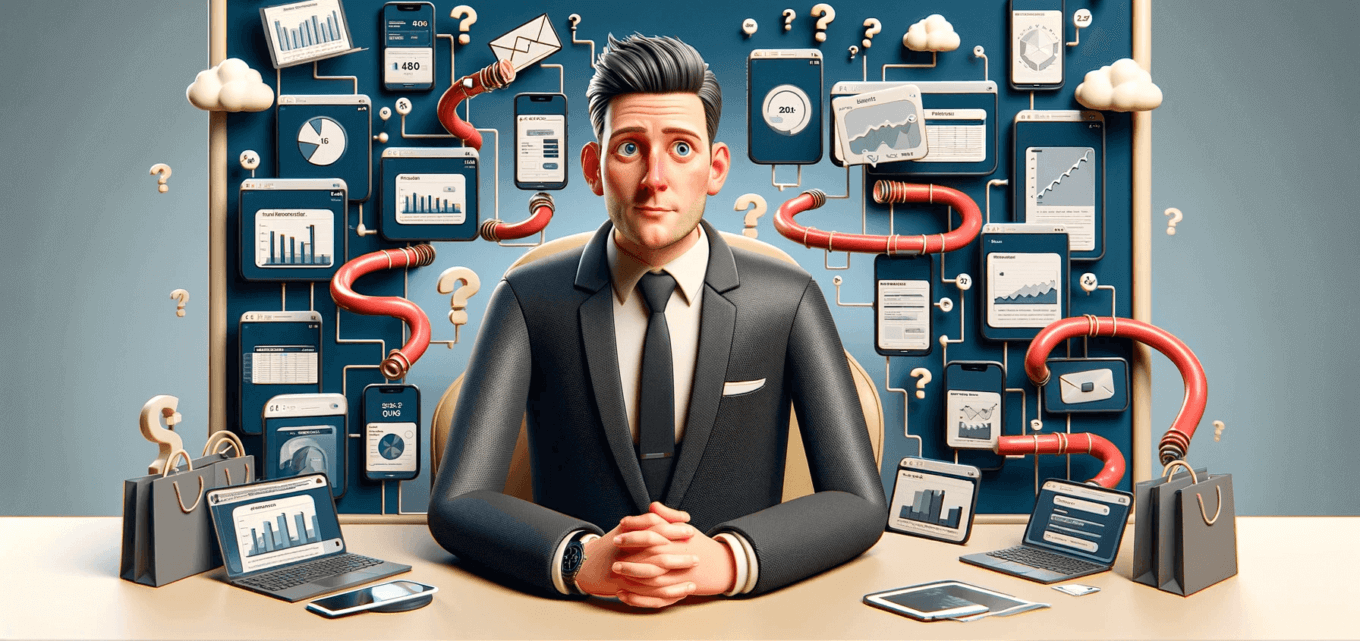It’s no secret that the digital age has transformed the way we do business. But just how much of the buyer’s journey is now digital?
As a B2B company, it’s important to understand the impact of digital transformation on your customers’ buying behavior.
In today’s world, buyers have access to a wealth of information at their fingertips, thanks to digital channels and platforms. From initial research to making a purchase decision, much of the buyer’s journey now takes place online. But just how much? Let’s dive into the world of digitalization in the buyer’s journey from a B2B perspective.

Key Takeaways:
- The buyer’s journey has become increasingly digital in the digital age
- Digital transformation has had a significant impact on B2B buying behavior
- Understanding the influence of digital on the buyer’s journey is crucial in today’s world
Understanding the Buyer’s Journey in the Digital Age
So, you want to understand the buyer’s journey in the digital age? Well, buckle up because it’s a wild ride. In today’s world, digital is king, and that includes the buying process.
Thanks to the wonders of the internet, consumers now have access to a wealth of information at their fingertips. From product reviews to social media influencers, the digital world has transformed the way we research and shop for products.
But it’s not just consumers that have gone digital. B2B buyers have also jumped onboard the digital train, with the vast majority of the buyer’s journey now taking place online.
So, why has digital become such an important part of the buyer’s journey? Well, for one, it’s convenient. With just a few clicks, buyers can access product information, compare prices, and make purchases – all from the comfort of their homes or offices.
But it’s not just about convenience. Digital has also enabled buyers to become more informed and empowered. With access to a wealth of information, buyers are now able to make more informed purchasing decisions and have greater control over the buying process.
So, if you want to succeed in the digital age, it’s important to understand the role that digital plays in the buyer’s journey. By embracing digital and creating a seamless digital experience for your customers, you can stay ahead of the curve and drive business growth.
The Influence of Digital on the Buyer’s Journey
So, you’ve heard that digital is changing the game when it comes to the buyer’s journey. But how much of an impact is it really having? Well, let’s just say that measuring digital influence in the buyer’s journey is no easy feat.
With so many touchpoints and channels available, it can be difficult to pinpoint exactly where digital is having the most impact. However, one thing is for sure – the impact of digital on the buyer’s journey is significant.
From online research to social media recommendations, digital channels are playing an increasingly important role in shaping the buyer’s decision-making process. In fact, studies have shown that as much as 70% of the buyer’s journey is now completed digitally.
| Digital Touchpoints | Impact on the Buyer’s Journey |
|---|---|
| Social Media | Provides peer recommendations and social proof |
| Search Engines | Allows buyers to research and compare products and services |
| Email Marketing | Delivers targeted messaging directly to the buyer’s inbox |
But it’s not just about the channels themselves – it’s also about the content that’s being delivered. Digital allows businesses to deliver personalized, relevant messaging that speaks directly to the needs and pain points of their target audience.
So, what does all this mean for your business? Well, it means that if you’re not embracing digital in your marketing and sales efforts, you’re likely missing out on a huge opportunity to connect with your audience and drive conversions.
“The impact of digital on the buyer’s journey is like the impact of a tidal wave on a sandcastle. It’s a game changer, and businesses that fail to adapt will surely be left in the dust.”
The Impact of Digital on B2B Buying Behavior
While the impact of digital on the buyer’s journey is clear, it’s important to understand how it specifically affects B2B buying behavior. In the B2B context, digital allows buyers to:
- Research potential vendors and partners
- Compare product features and pricing
- Read reviews and testimonials from other businesses
- Get in touch with sales representatives
All of these touchpoints provide an opportunity for businesses to showcase their expertise and value proposition. However, it’s important to remember that the B2B buying process is typically more complex and involves multiple decision-makers.
As such, B2B businesses need to ensure that their digital marketing and sales efforts are coordinated and aligned to provide a seamless buyer experience across all touchpoints.
So, now that you understand the impact of digital on the buyer’s journey, it’s time to start thinking about how your business can leverage digital to connect with your audience and drive conversions.
Digitalization and Changes in the Buyer’s Journey
Oh, the times they are a-changin’, especially in the world of B2B buying. Thanks to digital transformation, the buyer’s journey has taken on a whole new look, and you need to be aware of the changes that have occurred.
First of all, let’s talk about the digitalization of the buyer’s journey. It used to be that buyers would rely on traditional methods to research and evaluate products or services, but now they are turning to digital channels to guide their decision-making process. This means your online presence has never been more important, so make sure your website, social media, and other digital touchpoints are up to par.
But digitalization goes beyond just the channels used in the buyer’s journey. The rise of digital has disrupted traditional buying patterns, and businesses need to adapt to stay relevant. Power used to be firmly in the hands of the seller, but now buyers have more information and more choices at their fingertips, putting them in control. And with increased transparency and access to information, buyers now have higher expectations for their purchasing journey.
So, what does all this mean for your business? It means you need to embrace digital transformation and be prepared for the changes that have come with it. Keep your finger on the pulse of emerging technologies and trends, and be ready to adapt to the ever-evolving needs and expectations of your customers. By doing so, you can navigate the digital buyer’s journey with ease and set your business up for success.
Navigating the Digital Buyer’s Journey in B2B
So, you understand the importance of digital transformation in the buyer’s journey and the digitalization of consumer behavior. But how do you navigate this new landscape in the B2B context?
First and foremost, it’s essential to align your marketing and sales efforts. Digital tools and platforms allow for a seamless integration between the two, allowing for a more cohesive and effective strategy.
Next, consider the unique needs and preferences of your B2B buyers. While the digitalization of consumer behavior is widespread, B2B buyers still have specific pain points and requirements. By understanding their perspective, you can tailor your approach and provide a more personalized experience.
Don’t forget to leverage the power of data. Digital channels provide a wealth of information about your customers’ behavior, preferences, and pain points. By analyzing this data, you can gain insights that allow you to optimize your marketing and sales efforts and provide a more tailored experience.
Finally, embrace innovation. The transformative power of digital is constantly expanding, and it’s essential to stay ahead of the curve. Be open to emerging technologies and trends, and invest in the tools and platforms that will enable you to provide a seamless, convenient, and personalized experience for your B2B buyers.
With these strategies in place, you’ll be well-equipped to navigate the digital buyer’s journey in the B2B context. Remember, digital transformation isn’t a one-time event – it’s an ongoing process of adaptation and innovation.
The Future of the Buyer’s Journey: Embracing Digital
So, you’ve made it this far and you’re still not convinced of the importance of digital in the buyer’s journey? Well, let us paint a picture of the future for you.
As technology continues to advance, the buyer’s journey will become even more digitalized. In fact, experts predict that by 2025, the digital economy will account for more than half of the world’s economy.
What does this mean for you as a business? It means that you need to embrace digital transformation in the buyer’s journey if you want to stay relevant and competitive. No longer can you rely solely on traditional sales and marketing tactics to win over customers. You must adapt and evolve with the times.
The Importance of Digital in the Buyer’s Journey
Let’s face it, the buyer’s journey is no longer a linear path. Consumers today have access to a plethora of information and resources at their fingertips, and they expect a seamless digital experience at each stage of their journey.
From researching products and services to making a purchase decision, the buying process has become increasingly digital. And businesses that don’t prioritize the digital experience are missing out on a huge opportunity to connect with customers and drive sales.
By embracing digital, you can provide a personalized and engaging experience for your customers that sets you apart from the competition. You can use data and analytics to better understand your customers’ needs and preferences, and tailor your marketing and sales efforts accordingly.
The Role of Digital Transformation in the Buyer’s Journey
Digital transformation is not just a buzzword. It’s a critical component of staying relevant in today’s business landscape. And it’s not just about implementing new technology, it’s about fundamentally changing the way you do business.
By leveraging digital tools and platforms, you can streamline your operations, improve efficiency, and create a more seamless customer experience. You can automate processes, enable self-service options, and provide real-time support to meet the needs of today’s digitally-savvy customers.
Embracing the Future
As the digital economy continues to grow, it’s essential that businesses adapt and evolve with the times. And that means embracing digital in the buyer’s journey.
To stay ahead of the curve, you need to invest in digital transformation and prioritize the customer experience. You need to use data and analytics to better understand your customers, and leverage technology to provide a seamless and engaging digital experience at every stage of the buyer’s journey.
The future of the buyer’s journey is digital. Are you ready to embrace it?

